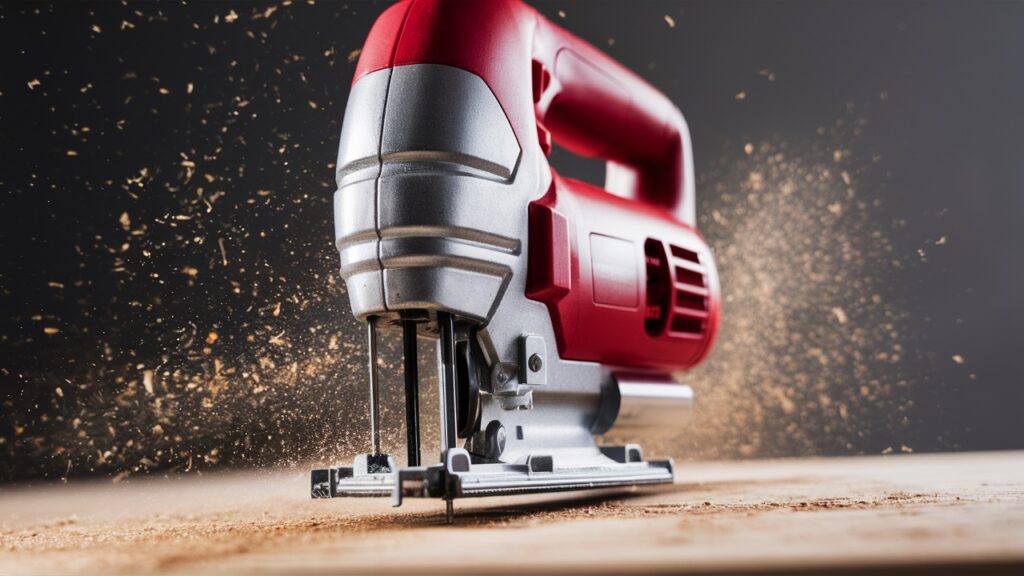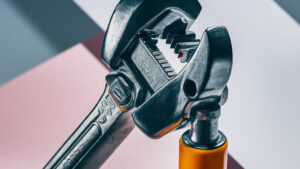To use a jigsaw tool, start by selecting the right blade for your material. Secure your workpiece and guide the jigsaw along the desired cutting line.
A jigsaw is a versatile power tool perfect for making intricate cuts in various materials like wood, metal, and plastic. Ideal for DIY projects and professional tasks, it allows for curves and straight lines alike. The jigsaw’s lightweight design and ease of use make it a favorite among craftsmen and hobbyists.
Understanding the basics of this tool can significantly enhance your cutting efficiency and precision. Whether you’re tackling home repairs or artistic projects, mastering the jigsaw is essential. Explore the best practices for setup, safety, and technique to achieve flawless results with your jigsaw.
Introduction To Jigsaw Tools
A jigsaw is a versatile and essential tool for many projects. It cuts through various materials with ease. Wood, metal, and plastic are just a few examples. Jigsaws are perfect for both beginners and experienced users. Their design allows for intricate cuts and curves.
The Versatility Of Jigsaws
Jigsaws offer many uses in different fields. Here are some common applications:
- Woodworking: Create detailed designs and patterns.
- Metalworking: Cut thin sheets of metal accurately.
- Crafting: Make unique art pieces with precision.
- Home Improvement: Cut out shapes for fixtures and fittings.
Jigsaws can handle various materials, making them a must-have. Different blade types suit different tasks. Choose wisely based on your project needs.
Key Features To Look For
When selecting a jigsaw, consider these important features:
| Feature | Description |
|---|---|
| Power Rating | Higher power for tougher materials. |
| Variable Speed | Adjust speed for different materials. |
| Blade Types | Different blades for specific cuts. |
| Bevel Cutting | Ability to cut angles for joints. |
| Weight | Lightweight tools are easier to handle. |
Choose a jigsaw that fits your needs and skill level. Understanding these features ensures better performance. Invest in quality for lasting results.

Safety First
Using a jigsaw can be fun and rewarding. Safety should always come first. Proper precautions ensure that you work safely. Here are some essential tips to follow.
Proper Protective Gear
Wearing the right gear protects you from accidents. Here’s a list of essential protective gear:
- Safety Glasses: Protects your eyes from debris.
- Dust Mask: Keeps harmful dust out of your lungs.
- Ear Protection: Reduces noise exposure from the tool.
- Gloves: Provides grip and protects your hands.
- Steel-Toed Boots: Protects your feet from heavy objects.
Jigsaw Handling Basics
Correct handling of a jigsaw is crucial. Follow these basic rules:
- Always check the tool before using it.
- Ensure the blade is sharp and properly installed.
- Keep hands away from the blade path.
- Turn off the jigsaw before changing blades.
- Use clamps to secure your workpiece.
- Work in a well-lit area for better visibility.
Remember to keep the work area clean. A tidy space reduces the risk of accidents. Stay focused and avoid distractions while working.
Setting Up Your Workspace
Creating a safe and organized workspace is essential for using a jigsaw. Proper setup prevents accidents and improves your cutting accuracy. Follow these steps to prepare your area effectively.
Choosing The Right Surface
Select a flat, sturdy surface for your jigsaw. A workbench or a table works best. Avoid uneven or unstable surfaces. Here are some options:
- Workbench: Provides stability and height.
- Table: Ensure it can hold the material.
- Floor: Use a mat for safety if needed.
Consider the following factors:
| Factor | Importance |
|---|---|
| Stability | Prevents vibrations during cutting. |
| Height | Reduces strain on your back. |
| Space | Allows for easy movement around materials. |
Securing Materials For Cutting
Securing your materials is key for precise cuts. Loose materials can shift and cause accidents. Use these methods:
- Clamps: Use to hold the material in place.
- Braces: Position against walls or heavy objects.
- Non-slip mats: Help keep materials steady.
Always check the security of your setup. A stable workspace leads to better results. Take time to ensure everything is in place.
Choosing The Right Blade
Choosing the correct jigsaw blade is vital for your project. The right blade can make cutting easier and improve results. Different blades work better with different materials. Understanding blade types and their uses helps you select the best option.
Types Of Jigsaw Blades
Jigsaw blades come in various types. Each type serves a specific purpose. Here’s a quick overview:
| Blade Type | Best For |
|---|---|
| Wood Blades | Cutting soft and hardwoods |
| Metal Blades | Cutting thin metal sheets |
| Plastic Blades | Cutting plastic materials |
| Tile Blades | Cutting ceramic and porcelain tiles |
| Specialty Blades | Unique materials like fiberglass |
Matching Blades To Material
Matching your jigsaw blade to the material is essential. Each material requires a specific blade type for best results. Here’s how to match blades:
- Wood: Use wood blades with larger teeth.
- Metal: Choose metal blades with fine teeth.
- Plastic: Select blades designed for plastic cutting.
- Tile: Use diamond-tipped blades for tiles.
- Fiberglass: Specialty blades work best.
Consider the thickness of the material too. Thicker materials need stronger blades. Check the teeth per inch (TPI) for better performance:
- Low TPI (3-6): Ideal for wood.
- Medium TPI (8-10): Great for plastic.
- High TPI (14+): Best for metal.
Choosing the right blade makes your jigsaw cuts smooth and precise. Always pick a blade that matches your material.
Mastering The Cut
Mastering the cut with a jigsaw opens up a world of creativity. Precision and control are key to achieving clean edges and intricate designs. Follow these steps to enhance your cutting skills.
Starting Your Cut
Begin your cut with confidence. Here are the steps:
- Select the right blade for your material. Choose a fine tooth blade for wood and a metal cutting blade for metals.
- Mark your cut line clearly. Use a pencil for accuracy.
- Clamp your material down securely. This prevents movement during cutting.
- Start the jigsaw at a low speed. Gradually increase speed as you cut.
- Keep your eyes on the blade. Follow the marked line closely.
Navigating Curves And Angles
Cutting curves and angles takes practice. Use these tips for better results:
- <stron
Advanced Jigsaw Techniques
Mastering advanced jigsaw techniques can elevate your woodworking skills. These methods allow for precision and creativity in various projects. Explore ways to make bevel cuts and use guides for accuracy.
Making Bevel Cuts
Bevel cuts add unique angles to your projects. Here’s how to achieve them:
- Set the Angle: Adjust the base plate of your jigsaw. Most jigsaws allow for angles between 0° and 45°.
- Secure Your Workpiece: Clamp it down. This prevents movement during cutting.
- Choose the Right Blade: Use a fine-tooth blade for cleaner cuts.
- Cut Slowly: This ensures accuracy and reduces splintering.
Practice on scrap wood first. This builds confidence and skill. Adjust your settings based on material thickness.
Using Guides For Precision
Guides help maintain a straight line during cuts. Here are some options:
- Edge Guides: These attach to the jigsaw. They keep the blade aligned.
- Straight Edges: Use a level or ruler as a guide. Clamp it to your workpiece.
- Jigsaw Table: A dedicated table offers more stability for larger pieces.
Follow these steps for using guides:
- Mark your cut line clearly on the material.
- Align the guide with the cut line.
- Ensure the jigsaw blade is touching the guide.
- Start cutting, keeping the jigsaw steady against the guide.
Using guides will enhance your cutting precision. The right technique makes all the difference.
Maintenance And Care
Proper maintenance and care will keep your jigsaw in top shape. Regular cleaning and timely replacements extend its lifespan. This section covers essential maintenance steps.
Cleaning Your Jigsaw
Cleaning your jigsaw is crucial for its performance. Follow these steps for effective cleaning:
- Unplug the jigsaw before cleaning.
- Use a soft brush to remove dust.
- Wipe the base plate with a damp cloth.
- Check and clear any debris from the blade area.
- Inspect the air vents for blockages.
Regular cleaning helps maintain accuracy. Avoid using harsh chemicals. Stick to mild soap and water.
Replacing Blades And Parts
Replacing blades and parts is vital for cutting efficiency. Follow these steps:
- Disconnect the jigsaw from power.
- Open the blade clamp using the release lever.
- Remove the old blade carefully.
- Insert the new blade, ensuring it fits snugly.
- Close the clamp securely.
Check the jigsaw’s manual for specific part replacements. Pay attention to:
| Part | Replacement Frequency | Notes |
|---|---|---|
| Blades | After 5-10 cuts | Choose blades based on material. |
| Base Plate | As needed | Replace if damaged. |
| Motor Brushes | Every 6 months | Replace for optimal power. |
Regular checks ensure safe and efficient operation. Keeping a well-maintained jigsaw enhances your woodworking projects.
Troubleshooting Common Issues
Using a jigsaw can be fun and rewarding. Yet, problems may arise during your project. Here are solutions to common issues you might face.
Solving Blade Deflection
Blade deflection occurs when the blade bends during cutting. This can lead to inaccurate cuts. Here’s how to fix it:
- Check Blade Type: Ensure you use the right blade for your material.
- Use a Thicker Blade: A thicker blade provides more stability.
- Adjust Cutting Speed: Slower speeds reduce deflection.
- Support the Material: Use a workbench or clamps to stabilize it.
By following these steps, you can minimize blade deflection and achieve precise cuts.
Dealing With Rough Edges
Rough edges can ruin the look of your project. Here are steps to smooth them out:
- Sand the Edges: Use sandpaper or a sanding block for a smooth finish.
- Choose the Right Grit: Start with coarse grit, then move to fine grit.
- Use a Router: A router can create clean, rounded edges.
- Inspect Regularly: Check your edges frequently as you work.
With these methods, you can effectively deal with rough edges and enhance your project’s appearance.
Creative Projects To Try
Jigsaws are versatile tools. They can bring your creative ideas to life. Here are some exciting projects that you can try with your jigsaw.
Home Decor Ideas
Transform your living space with unique home decor projects. Use your jigsaw to create beautiful pieces. Here are some ideas:
- Wall Art: Cut intricate designs from wood or acrylic.
- Picture Frames: Craft custom frames to showcase your photos.
- Coasters: Create personalized coasters from wood slices.
- Shelves: Make decorative shelves in fun shapes.
- Signs: Design wooden signs for your home.
These projects will not only beautify your space but also impress your guests. Choose materials that fit your style.
Woodworking With Jigsaws
Woodworking is fun and rewarding. Jigsaws make woodworking easy for everyone. Here are some projects to consider:
- Birdhouses: Build a cozy home for your feathered friends.
- Furniture: Create unique tables or chairs.
- Toys: Craft wooden toys for children.
- Decorative Boxes: Make small boxes for storage.
- Garden Projects: Design planters or garden signs.
Woodworking projects can enhance your skills. Start with simple designs and gradually try more complex ones. Enjoy the process of creating something special.
Frequently Asked Questions
How Do I Start Using A Jigsaw?
To start using a jigsaw, first, select the right blade for your material. Secure your workpiece firmly to prevent movement. Adjust the jigsaw’s speed according to the material thickness. Always wear safety goggles and follow the manufacturer’s instructions for best practices.
Practice on scrap material if you’re a beginner.
What Materials Can A Jigsaw Cut?
A jigsaw is versatile and can cut various materials. It effectively cuts wood, plastic, and metal with the right blade. Some jigsaws can also handle ceramic tiles and laminated surfaces. Always choose the appropriate blade for the material to ensure clean cuts and avoid damage.
How Do I Choose The Right Jigsaw Blade?
Choosing the right jigsaw blade depends on your material. For wood, use a high-tooth count blade for smooth cuts. For metal, select a bi-metal blade for durability. Additionally, consider the thickness of the material and the desired cut finish. Always consult the jigsaw manual for blade recommendations.
Can I Make Curved Cuts With A Jigsaw?
Yes, a jigsaw is excellent for making curved cuts. Use a fine-toothed blade for tighter curves and slower speeds. Mark your cutting line clearly for better accuracy. Guide the jigsaw slowly along the curve, allowing the blade to do the work.
Practice will improve your technique over time.
Conclusion
Mastering the jigsaw tool opens up endless possibilities for your DIY projects. With practice, you can create precise cuts and intricate designs. Always prioritize safety and maintain your tool for optimal performance. Embrace your creativity, and let the jigsaw enhance your woodworking skills.
Start crafting today and transform your ideas into reality!








